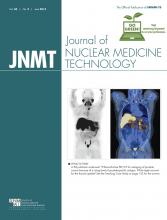As nuclear medicine technology students, we occasionally encounter opportunities to gain experience outside the classroom and away from the clinical setting. We recently received an opportunity to assist a nuclear medicine physician at the University of Alabama at Birmingham Hospital in conducting a survey on hepatobiliary iminodiacetic acid (HIDA) scanning. The same survey had been conducted about 4 years previously, before the most recent (2010) procedure guideline on HIDA scanning had been published by the Society of Nuclear Medicine and Molecular Imaging. The physician wanted to repeat the survey and compare the results with the previous results to see if the updated guideline had altered clinical practice in Alabama. Our task was to contact all nuclear medicine sites, such as hospitals and outpatient facilities, in Alabama and ask about aspects of their HIDA protocol such as patient preparation, the fatty meal used, and the dose and duration of cholecystokinin infusion. The survey results will be submitted for publication in a peer-reviewed journal.
As senior students in the nuclear technology program, we have enough knowledge at this point to have a good understanding of the procedure for HIDA scans. We understand important study variables such as how to determine the appropriate cholecystokinin dose, how to administer the cholecystokinin, and how to correctly position the patient. Having several months of clinical experience, we realize that each facility has its own way of performing the various nuclear medicine examinations. Most sites were helpful in assisting with the survey, and we found it interesting to hear about the different types of HIDA protocols that are used by different clinics. However, once we began calling facilities, it became evident that this project was not going to be as simple as we originally thought. What we expected to take a week or two actually took about 4 weeks. Not only did we have to balance our class and clinic schedules, but we also had to schedule enough time to call each facility—time not just to perform the interview but to first maneuver through the maze of phone connections just to reach the nuclear medicine department.
We frequently became discouraged when we could not reach certain technologists either because they were with a patient or because they had gone home by the time our classes or clinic shift ended and we finally had a chance to place the calls. It became important for us to remind ourselves of what we were doing—participating in an information-gathering project. We coined a mnemonic, P-R-O-J-E-C-T, to help bolster our diligence as we worked our way through contacting the over 70 nuclear medicine departments across Alabama:
Persistence
Persistence was needed to continue to contact some sites until we could reach someone. Not every site had the same availability.
Realistic expectation
The expectation that the data would not simply be handed to us—that it would take quality effort to get quality results—kept us grounded in reality.
Organization
Organization prevented duplicate interviews and made it easier to enter and analyze data.
Juggling
The need to juggle the survey project with our lives as senior students was ever present, especially during finals week.
Excitement
Excitement about the outcome made the project seem less like work and more like solving a mystery. Also, our excitement spread to the sites and made them more receptive to answering our questions.
Communication
Good communication both with the sites and with each other was needed to acquire accurate information and stay on track.
Time
Time management was essential to balancing our student schedules with time for our 70 survey interviews.
We found it insightful to learn of the variety of HIDA protocols in use throughout the state. Students are sent to various sites to learn different ways of performing procedures but cannot travel to every facility in a state. Through conducting this survey, we had an opportunity to hear from many more technologists than would otherwise have been possible, thereby gaining rich insight into the world of nuclear medicine.
Footnotes
-
Published online Apr. 9, 2015.







